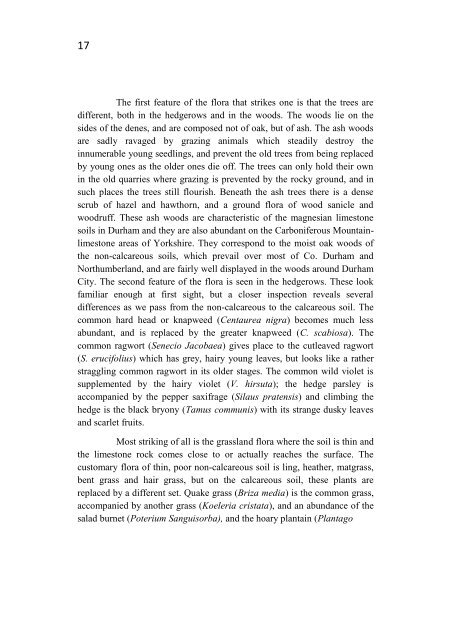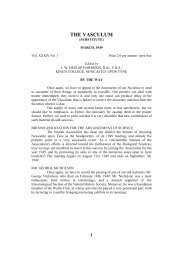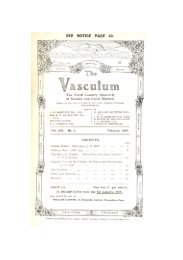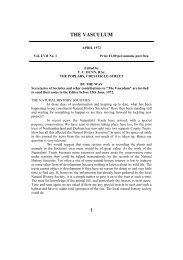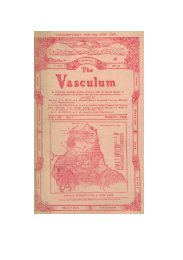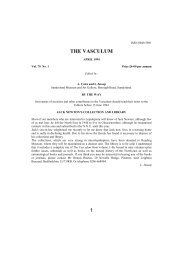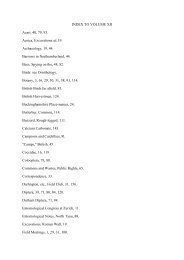1938 - The Vasculum
1938 - The Vasculum
1938 - The Vasculum
You also want an ePaper? Increase the reach of your titles
YUMPU automatically turns print PDFs into web optimized ePapers that Google loves.
17<br />
<strong>The</strong> first feature of the flora that strikes one is that the trees are<br />
different, both in the hedgerows and in the woods. <strong>The</strong> woods lie on the<br />
sides of the denes, and are composed not of oak, but of ash. <strong>The</strong> ash woods<br />
are sadly ravaged by grazing animals which steadily destroy the<br />
innumerable young seedlings, and prevent the old trees from being replaced<br />
by young ones as the older ones die off. <strong>The</strong> trees can only hold their own<br />
in the old quarries where grazing is prevented by the rocky ground, and in<br />
such places the trees still flourish. Beneath the ash trees there is a dense<br />
scrub of hazel and hawthorn, and a ground flora of wood sanicle and<br />
woodruff. <strong>The</strong>se ash woods are characteristic of the magnesian limestone<br />
soils in Durham and they are also abundant on the Carboniferous Mountainlimestone<br />
areas of Yorkshire. <strong>The</strong>y correspond to the moist oak woods of<br />
the non-calcareous soils, which prevail over most of Co. Durham and<br />
Northumberland, and are fairly well displayed in the woods around Durham<br />
City. <strong>The</strong> second feature of the flora is seen in the hedgerows. <strong>The</strong>se look<br />
familiar enough at first sight, but a closer inspection reveals several<br />
differences as we pass from the non-calcareous to the calcareous soil. <strong>The</strong><br />
common hard head or knapweed (Centaurea nigra) becomes much less<br />
abundant, and is replaced by the greater knapweed (C. scabiosa). <strong>The</strong><br />
common ragwort (Senecio Jacobaea) gives place to the cutleaved ragwort<br />
(S. erucifolius) which has grey, hairy young leaves, but looks like a rather<br />
straggling common ragwort in its older stages. <strong>The</strong> common wild violet is<br />
supplemented by the hairy violet (V. hirsuta); the hedge parsley is<br />
accompanied by the pepper saxifrage (Silaus pratensis) and climbing the<br />
hedge is the black bryony (Tamus communis) with its strange dusky leaves<br />
and scarlet fruits.<br />
Most striking of all is the grassland flora where the soil is thin and<br />
the limestone rock comes close to or actually reaches the surface. <strong>The</strong><br />
customary flora of thin, poor non-calcareous soil is ling, heather, matgrass,<br />
bent grass and hair grass, but on the calcareous soil, these plants are<br />
replaced by a different set. Quake grass (Briza media) is the common grass,<br />
accompanied by another grass (Koeleria cristata), and an abundance of the<br />
salad burnet (Poterium Sanguisorba), and the hoary plantain (Plantago


